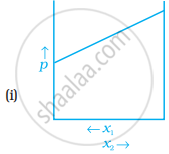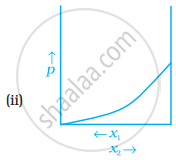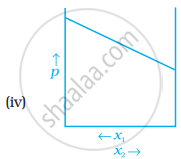Advertisements
Advertisements
प्रश्न
For a binary ideal liquid solution, the variation in total vapour pressure versus composition of solution is given by which of the curves?



उत्तर


Explanation:
The slopes at (i) and (iv) are striaght lines, therefore they represent ideal behaviour of the solution.
APPEARS IN
संबंधित प्रश्न
30 g of urea (M = 60 g mol−1) is dissolved in 846 g of water. Calculate the vapour pressure of water for this solution if vapour pressure of pure water at 298 K is 23·8 mm Hg.
State Raoult's law for the solution containing volatile components. What is the similarity between Raoult's law and Henry's law?
The vapour pressure of pure benzene at a certain temperature is 0.850 bar. A non-volatile, nonelectrolyte solid weighing 0.5 g is added to 39.0 g of benzene (molar mass 78 g/mol). The vapour pressure of the solution then is 0.845 bar. What is the molecular mass of the solid substance?
The vapour pressure of pure benzene at 25°C is 640 mm Hg and that of solution of solute A is 630 mm Hg. The molality of a solution is:
The solubility of a solid in a liquid is significantly affected by temperature changes.
\[\ce{Solute + Solvent -> Solution}\]
The system being in a dynamic equilibrium must follow Le-chatelier’s principle.
Considering the Le-chatelier’s principle which of the following is correct?
At a particular temperature, the vapour pressures of two liquids A and B are respectively 120 and 180 mm of mercury. If 2 moles of A and 3 moles of B are mixed to form an ideal solution, the vapour pressure of the solution at the same temperature will be (in mm of mercury):
A solution containing 10 g per dm3 of urea (molecular mass = 60 g mol–1) is isotonic with a 5% solution of a non-volatile solute. The molecular mass of this non-volatile solute is:
The vapour pressure of a solvent decreases by 10 mm of Hg when a non-volatile solute was added to the solvent. The mole fraction of the solute in the solution is 0.2. What should be the mole fraction of the solvent if the decrease in the vapour pressure is to be 20 mm of Hg?
Why is the vapour pressure of an aqueous solution of glucose lower than that of water?
The vapour pressure of a 5% aqueous solution of non-volatile organic substance at 373 k is 745 mm. calculated the molecular mass of the solute
